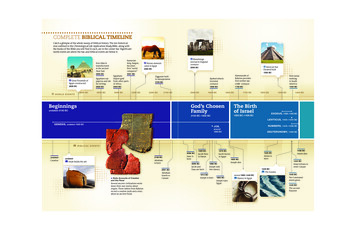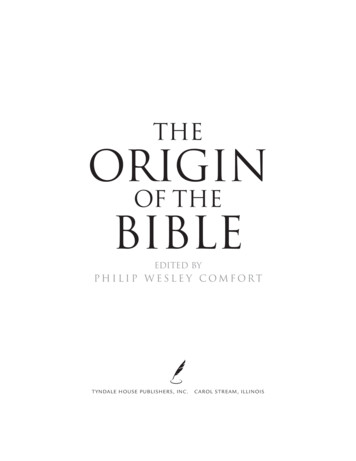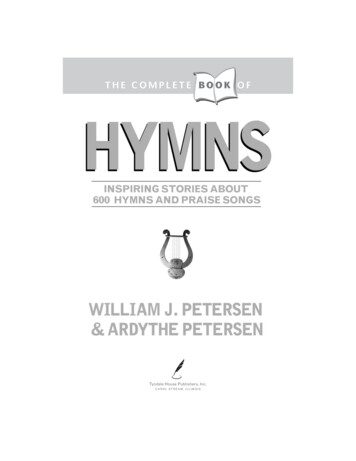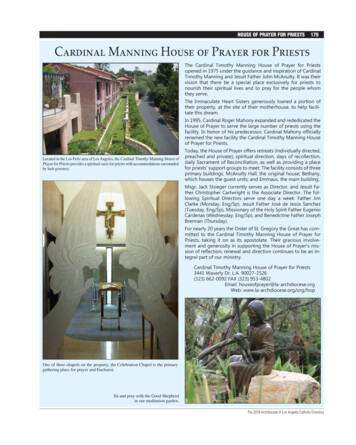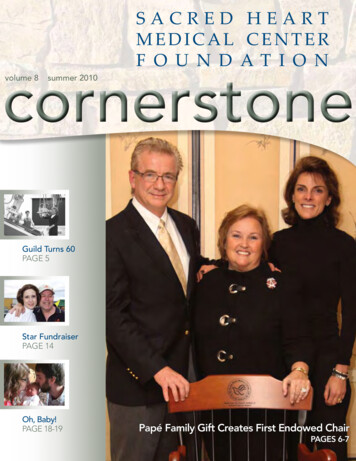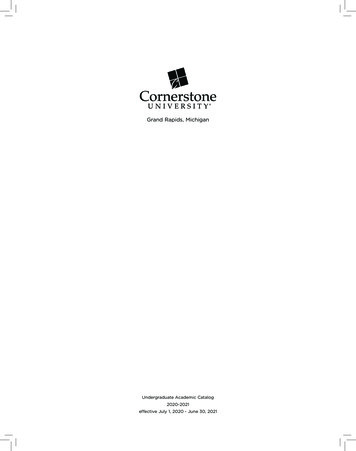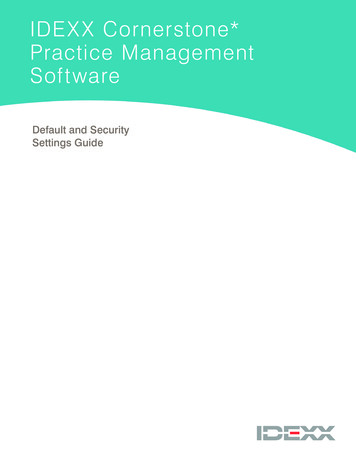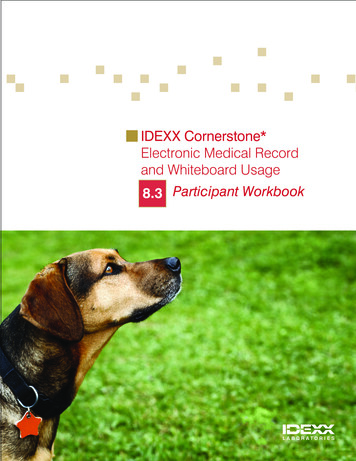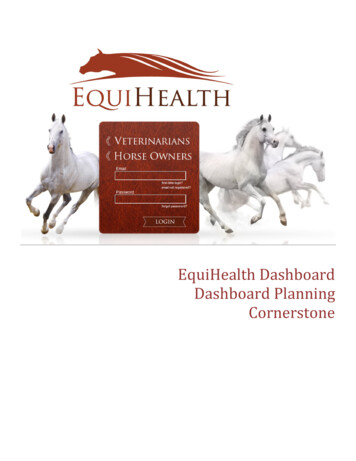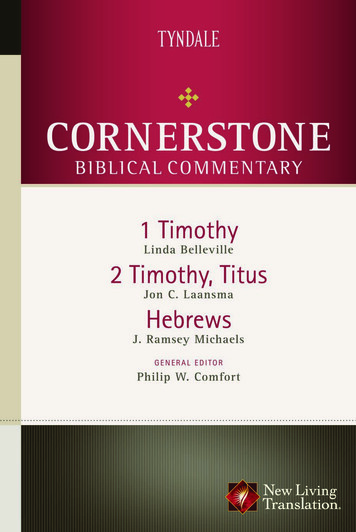
Transcription
CORNERSTONEBIBLICALCOMMENTARY
General EditorPhilip W. ComfortD. Litt. et Phil., University of South Africa;Tyndale House Publishers;Coastal Carolina University.Consulting Editor, Old TestamentTremper Longman IIIPhD, Yale University;Robert H. Gundry Professor of Biblical Studies, Westmont College.Consulting Editor, New TestamentGrant R. OsbornePhD, University of Aberdeen;Professor of New Testament, Trinity Evangelical Divinity School.Associate EditorsJason DriesbachMA, Biblical Exegesis and Linguistics, Dallas Theological Seminary;Tyndale House Publishers.Mark R. NortonMA, Theological Studies, Wheaton Graduate School;Tyndale House Publishers.James A. SwansonMSM, Multnomah Biblical Seminary;MTh, University of South Africa;Tyndale House Publishers.
CORNERSTONEBIBLICALCOMMENTARY1 TimothyLinda Belleville2 Timothy, TitusJon C. LaansmaHebrewsJ. Ramsey MichaelsGENERAL EDITORPhilip W. Comfortfeaturing the text of theNEW LIVING TRANSLATIONTYNDALE HOUSE PUBLISHERS, INC. CAROL STREAM, ILLINOIS
Cornerstone Biblical Commentary, Volume 17Visit Tyndale’s exciting Web site at www.tyndale.com1 Timothy copyright 2009 by Linda Belleville. All rights reserved.2 Timothy copyright 2009 by Jon C. Laansma. All rights reserved.Titus copyright 2009 by Jon C. Laansma. All rights reserved.Hebrews copyright 2009 by J. Ramsey Michaels. All rights reserved.Designed by Luke Daab and Timothy R. Botts.Unless otherwise indicated, all Scripture quotations are taken from the Holy Bible,New Living Translation, copyright 1996, 2004, 2007 by Tyndale House Foundation.Used by permission of Tyndale House Publishers, Inc., Carol Stream, Illinois 60188.All rights reserved.TYNDALE, New Living Translation, NLT, Tyndale’s quill logo, and the New LivingTranslation logo are registered trademarks of Tyndale House Publishers, Inc.Library of Congress Cataloging-in-Publication DataCornerstone biblical commentary.p. cm.Includes bibliographical references and index.ISBN-13: 978-0-8423-8345-5 (hc : alk. paper)ISBN-10: 0-8423-8345-X (hc : alk. paper)1. Bible—Commentaries. I. Belleville, Linda. II. Laansma, Jon C.III. Michaels, J. Ramsey.Printed in the United States of America15 14 13 12 11 10 09765432 1
CONTENTSContributors to Volume 17viGeneral Editor’s PrefaceviiAbbreviationsixTransliteration and Numbering Systemxiii1 & 2 TIMOTHY1TITUS221HEBREWS303
CONTRIBUTORS TO V O L U M E 1 71 Timothy: Linda BellevilleBM, Eastman School of Music, University of Rochester;MA, Trinity Evangelical Divinity School;PhD, University of St. Michael’s College, University of Toronto;Professor New Testament at Bethel College in Mishawaka, Indiana.2 Timothy, Titus: Jon C. LaansmaBRE, Grand Rapids Baptist College;MDiv, Grand Rapids Baptist Seminary;PhD, University of Aberdeen;Associate Professor of Ancient Languages and New Testament at Wheaton College.Hebrews: J. Ramsey MichaelsAB, Princeton University;BD, Grace Theological Seminary;ThM, Westminster Theological Seminary;ThD, Harvard University;Professor of Religious Studies Emeritus at Missouri State University in Springfield, Missouri.
G E N E R A LE D I T O R ’ SP R E F A C EThe Cornerstone Biblical Commentary is based on the second edition of the NewLiving Translation (2007). Nearly 100 scholars from various church backgrounds and from several countries (United States, Canada, England, andAustralia) participated in the creation of the NLT. Many of these same scholarsare contributors to this commentary series. All the commentators, whetherparticipants in the NLT or not, believe that the Bible is God’s inspired word andhave a desire to make God’s word clear and accessible to his people.This Bible commentary is the natural extension of our vision for the NewLiving Translation, which we believe is both exegetically accurate and idiomatically powerful. The NLT attempts to communicate God’s inspired word in alucid English translation of the original languages so that English readers canunderstand and appreciate the thought of the original writers. In the same way,the Cornerstone Biblical Commentary aims at helping teachers, pastors, students,and laypeople understand every thought contained in the Bible. As such, thecommentary focuses first on the words of Scripture, then on the theologicaltruths of Scripture—inasmuch as the words express the truths.The commentary itself has been structured in such a way as to help readers getat the meaning of Scripture, passage by passage, through the entire Bible. EachBible book is prefaced by a substantial book introduction that gives generalhistorical background important for understanding. Then the reader is takenthrough the Bible text, passage by passage, starting with the New Living Translation text printed in full. This is followed by a section called “Notes,” wherein thecommentator helps the reader understand the Hebrew or Greek behind theEnglish of the NLT, interacts with other scholars on important interpretiveissues, and points the reader to significant textual and contextual matters. The“Notes” are followed by the “Commentary,” wherein each scholar presents alucid interpretation of the passage, giving special attention to context and majortheological themes.The commentators represent a wide spectrum of theological positions withinthe evangelical community. We believe this is good because it reflects the richvariety in Christ’s church. All the commentators uphold the authority of God’sword and believe it is essential to heed the old adage: “Wholly apply yourself tothe Scriptures and apply them wholly to you.” May this commentary help youknow the truths of Scripture, and may this knowledge help you “grow in yourknowledge of God and Jesus our Lord” (2 Pet 1:2, NLT).PHILIP W. COMFORTGENERAL EDITOR
A B B R E V I A T I O N SGENERAL ABBREVIATIONSb.BabylonianGemarabar.baraitac.circa, around,approximatelycf.confer, comparech, chs chapter, chapterscontra in contrast toDSSDead Sea Scrollsed.edition, editore.g.exempli gratia, forexampleet al.et alli, and othersfem.femininefffollowing (verses,pages)fl.flourishedGr.GreekHeb.ibid.i.e.in em, in the sameplaceid est, the samein loco, in the placecitedliterallySeptuagintMajority oretic Textno dateneuternumberNTOLOSOTp., pp.pl.Qrev.sg.t.TRv., vv.vid.viz.vol.y.New TestamentOld LatinOld SyriacOld Testamentpage, pagespluralQuelle (“Sayings”as Gospel source)revisionsingularToseftaTextus Receptusverse, versesvidetur, it seemsvidelicet, namelyvolumeJerusalem GemaraABBREVIATIONS FOR BIBLE TRANSLATIONSASVCEVESVGWHCSBJBKJVNABNASBAmerican StandardVersionContemporaryEnglish VersionEnglish StandardVersionGod’s WordHolman ChristianStandard BibleJerusalem BibleKing James VersionNew American BibleNew AmericanStandard BibleNCVNEBNETNIVNIrVNJBNJPSNew CenturyVersionNew English BibleThe NET BibleNew InternationalVersionNew InternationalReader’s VersionNew JerusalemBibleThe New JewishPublication ew King JamesVersionNew RevisedStandard VersionNew LivingTranslationRevised EnglishBibleRevised StandardVersionToday’s EnglishVersionThe Living BibleABBREVIATIONS FOR DICTIONARIES, LEXICONS,COLLECTIONS OF TEXTS, ORIGINAL LANGUAGE EDITIONSABD Anchor Bible Dictionary(6 vols., Freedman) [1992]ANEP The Ancient NearEast in Pictures (Pritchard)[1965]ANET Ancient Near EasternTexts Relating to the OldTestament (Pritchard)[1969]BAGD Greek-English Lexicon ofthe New Testament and OtherEarly Christian Literature,2nd ed. (Bauer, Arndt,Gingrich, Danker) [1979]BDAG Greek-English Lexicon ofthe New Testament and OtherEarly Christian Literature, 3rded. (Bauer, Danker, Arndt,Gingrich) [2000]BDB A Hebrew and EnglishLexicon of the Old Testament(Brown, Driver, Briggs)[1907]BDF A Greek Grammar of theNew Testament and OtherEarly Christian Literature(Blass, Debrunner, Funk)[1961]
ABBREVIATIONSxBHS Biblia HebraicaStuttgartensia (Elliger andRudolph) [1983]CAD Assyrian Dictionary ofthe Oriental Institute of theUniversity of Chicago [1956]COS The Context of Scripture(3 vols., Hallo and Younger)[1997–2002]DBI Dictionary of BiblicalImagery (Ryken, Wilhoit,Longman) [1998]DBT Dictionary of BiblicalTheology (2nd ed.,Leon-Dufour) [1972]DCH Dictionary of ClassicalHebrew (5 vols., D. Clines)[2000]DLNTD Dictionary of the LaterNew Testament and ItsDevelopment (R. Martin,P. Davids) [1997]DJD Discoveries in the JudeanDesert [1955–]DJG Dictionary of Jesusand the Gospels (Green,McKnight, Marshall) [1992]DOTP Dictionary of the OldTestament: Pentateuch(T. Alexander, D. W. Baker)[2003]DPL Dictionary of Paul andHis Letters (Hawthorne,Martin, Reid) [1993]DTIB Dictionary of TheologicalInterpretation of the Bible(Vanhoozer) [2005]EDNT Exegetical Dictionary ofthe New Testament (3 vols.,H. Balz, G. Schneider. ET)[1990–1993]HALOT The Hebrew andAramaic Lexicon of the OldTestament (L. Koehler,W. Baumgartner, J. Stamm;trans. M. Richardson)[1994–1999]IBD Illustrated Bible Dictionary(3 vols., Douglas, Wiseman)[1980]IDB The Interpreter’s Dictionaryof the Bible (4 vols., Buttrick)[1962]ISBE International StandardBible Encyclopedia (4 vols.,Bromiley) [1979–1988]KBL Lexicon in VeterisTestamenti libros (Koehler,Baumgartner) [1958]LCL Loeb Classical LibraryL&N Greek-English Lexicon ofthe New Testament: Based onSemantic Domains (Louwand Nida) [1989]LSJ A Greek-English Lexicon(9th ed., Liddell, Scott,Jones) [1996]MM The Vocabulary of theGreek New Testament(Moulton and Milligan)[1930; 1997]NA26 Novum TestamentumGraece (26th ed., NestleAland) [1979]NA27 Novum TestamentumGraece (27th ed., NestleAland) [1993]NBD New Bible Dictionary(2nd ed., Douglas, Hillyer)[1982]NIDB New InternationalDictionary of the Bible(Douglas, Tenney) [1987]NIDBA New InternationalDictionary of BiblicalArchaeology (Blaiklock andHarrison) [1983]NIDNTT New InternationalDictionary of New TestamentTheology (4 vols., C. Brown)[1975–1985]NIDOTTE New InternationalDictionary of Old TestamentTheology and Exegesis (5 vols.,W. A. VanGemeren) [1997]PGM Papyri graecae magicae:Die griechischenZauberpapyri. (Preisendanz)[1928]PG Patrologia Graecae (J. P.Migne) [1857–1886]TBD Tyndale Bible Dictionary(Elwell, Comfort) [2001]TDNT Theological Dictionaryof the New Testament(10 vols., Kittel, Friedrich;trans. Bromiley) [1964–1976]TDOT Theological Dictionaryof the Old Testament (8 vols.,Botterweck, Ringgren; trans.Willis, Bromiley, Green)[1974–]TLNT Theological Lexicon of theNew Testament (3 vols.,C. Spicq) [1994]TLOT Theological Lexicon ofthe Old Testament (3 vols.,E. Jenni) [1997]TWOT Theological Wordbookof the Old Testament (2 vols.,Harris, Archer) [1980]UBS3 United Bible Societies’Greek New Testament(3rd ed., Metzger et al.)[1975]UBS4 United Bible Societies’Greek New Testament(4th corrected ed., Metzgeret al.) [1993]WH The New Testament in theOriginal Greek (Westcott andHort) [1882]ABBREVIATIONS FOR BOOKS OF THE BIBLEOld sDeutJoshJudgRuthDeuteronomyJoshuaJudgesRuth1 Sam2 Sam1 Kgs2 Kgs1 Samuel2 Samuel1 Kings2 Kings
xiABBREVIATIONS1 Chr2 ChrEzraNehEsthJobPs, PssProvEccl1 Chronicles2 ChroniclesEzraNehemiahEstherJobPsalm, oelAmosSong of HebJas1 Pet2 Pet1 John2 John3 JohnJudeRevHebrewsJames1 Peter2 Peter1 John2 John3 JohnJudeRevelationNew TestamentMattMarkLukeJohnActsRom1 Cor2 CorGalMatthewMarkLukeJohnActsRomans1 Corinthians2 CorinthiansGalatiansEphPhilCol1 Thess2 Thess1 Tim2 TimTitusPhlmEphesiansPhilippiansColossians1 Thessalonians2 Thessalonians1 Timothy2 TimothyTitusPhilemonDeuterocanonicalBarAdd DanPr AzarBelSg ThreeSusBaruchAdditions to DanielPrayer of AzariahBel and the DragonSong of the ThreeChildrenSusanna1–2 EsdrAdd EsthEp JerJdt1–2 Macc3–4 Macc1–2 EsdrasAdditions to EstherEpistle of JeremiahJudith1–2 Maccabees3–4 MaccabeesPr ManPs 151SirTobWisPrayer of ManassehPsalm 151SirachTobitWisdom of SolomonMANUSCRIPTS AND LITERATURE FROM QUMRANInitial numerals followed by “Q” indicate particular caves at Qumran. For example,the notation 4Q267 indicates text 267 from cave 4 at Qumran. Further, 1QS 4:9-10indicates column 4, lines 9-10 of the Rule of the Community; and 4Q166 1 ii 2 indicatesfragment 1, column ii, line 2 of text 166 from cave 4. More examples of commonabbreviations are listed below.CD1QH1QIsaaCairo Geniza copyof the DamascusDocumentThanksgiving HymnsIsaiah copy a1QIsab1QM1QpHab1QSIsaiah copy bWar ScrollPesher HabakkukRule of ationsPsalmsTemple ScrollTargum of JobIMPORTANT NEW TESTAMENT MANUSCRIPTS(all dates given are AD; ordinal numbers refer to centuries)Significant Papyri ( Papyrus)P1 Matt 1; early 3rdP4 P64 P67 Matt 3, 5, 26;Luke 1–6; late 2ndP5 John 1, 16, 20; early 3rdP13 Heb 2–5, 10–12; early 3rdP15 P16 (probably part ofsame codex) 1 Cor 7–8,Phil 3–4; late 3rdP20 Jas 2–3; 3rdP22 John 15–16; mid 3rdP23 Jas 1; c. 200P27 Rom 8–9; 3rd
ABBREVIATIONSP30 1 Thess 4–5; 2 Thess 1;early 3rdP32 Titus 1–2; late 2ndP37 Matt 26; late 3rdP39 John 8; first half of 3rdP40 Rom 1–4, 6, 9; 3rdP45 Gospels and Acts; early 3rdP46 Paul’s Major Epistles (lessPastorals); late 2ndP47 Rev 9–17; 3rdP49 P65 Eph 4-5; 1 Thess1–2; 3rdxiiP52 John 18; c. 125P53 Matt 26, Acts 9–10;middle 3rdP66 John; late 2ndP70 Matt 2–3, 11–12, 24; 3rdP72 1–2 Peter, Jude; c. 300P74 Acts, General Epistles; 7thP75 Luke, John; c. 200P77 P103 (probably part ofsame codex) Matt 13–14,23; late 2ndP87 Philemon; late 2ndP90 John 18–19; late 2ndP91 Acts 2–3; 3rdP92 Eph 1; 2 Thess 1; c. 300P98 Rev 1:13-20; late 2ndP100 Jas 3–5; c. 300P101 Matt 3–4; 3rdP104 Matt 21; 2ndP106 John 1; 3rdP115 Rev 2–3, 5–6, 8–15; 3rdSignificant Uncials(Sinaiticus) most of NT; 4thA (Alexandrinus) most of NT;5thB (Vaticanus) most of NT; 4thC (Ephraemi Rescriptus) mostof NT with many lacunae;5thD (Bezae) Gospels, Acts; 5thD (Claromontanus), Paul’sEpistles; 6th (different MSthan Bezae)E (Laudianus 35) Acts; 6thF (Augensis) Paul’s Epistles; 9thG (Boernerianus) Paul’sEpistles; 9thH (Coislinianus) Paul’sEpistles; 6thI (Freerianus or Washington)Paul’s Epistles; 5thL (Regius) Gospels; 8thQ (Guelferbytanus B) Luke,John; 5thP (Porphyrianus) Acts—Revelation; 9thT (Borgianus) Luke, John; 5thW (Washingtonianus or theFreer Gospels) Gospels; 5thZ (Dublinensis) Matthew; 6th037 (D; Sangallensis) Gospels;9th1 Gospels, Acts, Paul’s Epistles;12th33 All NT except Revelation;9th81 Acts, Paul’s Epistles,General Epistles; 1044565 Gospels; 9th700 Gospels; 11th1424 (or Family 1424—agroup of 29 manuscriptssharing nearly the sametext) most of NT; 9th-10th1739 Acts, Paul’s Epistles; 10th2053 Revelation; 13th2344 Revelation; 11th038 (Q; Koridethi) Gospels;9th040 (X; Zacynthius) Luke; 6th043 (F; Beratinus) Matthew,Mark; 6th044 (Y; Athous Laurae)Gospels, Acts, Paul’sEpistles; 9th048 Acts, Paul’s Epistles,General Epistles; 5th0171 Matt 10, Luke 22;c. 3000189 Acts 5; c. 200Significant Minusculesf 1 (a family of manuscriptsincluding 1, 118, 131, 209)Gospels; 12th-14th13f (a family of manuscriptsincluding 13, 69, 124, 174,230, 346, 543, 788, 826,828, 983, 1689, 1709—known as the Ferrar group)Gospels; 11th-15thSignificant Ancient VersionsSYRIAC (SYR)syr c (Syriac Curetonian)Gospels; 5thsyrs (Syriac Sinaiticus)Gospels; 4thsyrh (Syriac Harklensis) EntireNT; 616OLD LATIN (IT)COPTIC (COP)it a (Vercellenis) Gospels; 4thit b (Veronensis) Gospels; 5thitd (Cantabrigiensis—the Latintext of Bezae) Gospels, Acts,3 John; 5thite (Palantinus) Gospels; 5thkit (Bobiensis) Matthew, Mark;c. 400copbo (Boharic—north Egypt)copfay (Fayyumic—central Egypt)copsa (Sahidic—southern Egypt)OTHER VERSIONSarm (Armenian)eth (Ethiopic)geo (Georgian)
TRANSLITERATION ANDNUMBERING SYSTEMNote: For words and roots from non-biblical languages (e.g., Arabic, Ugaritic),only approximate transliterations are given.HEBREW/ARAMAICConsonantsaalephB, bbethG, ggimelD, ddalethhhewwawzzayinjhethftethyyodhK, k, û kaphllamedh ’ b g d h w z kh t y k lm, µmemn, nunssamekh[ayinP, p, ¹ pex, ÅtsadheqqophrreshvshincsinT, ttaw m n s ‘ p ts q r sh s t, th(spirant)Vowels¾j¾;h;,eyeiiyipatakhfurtive patakhqametsfinal qamets hesegoltseretsere yodshort hireqlong hireqhireq yod a a a ah e e e i i i]y¾qamets khatufholemfull holemshort qibbutslong qibbutsshureqkhatef patakhkhatef qametsvocalic shewapatakh yodhezhqiepsilonzetaetathetaiota;o/uuW}Õ o o o u u u a o e aGreekabgalphabetagammaddelta a b g, n (beforeg, k, x, c) d e z e th i
NUMBERING SYSTEMklmnxoprs, kappalamdamunuksiomicronpirhosigmaxiv k l m n x o p r (ª rh) stufcywJtauupsilonphichipsiomegaroughbreathingmark t u ph ch ps o h (withvowel ordiphthong)THE TYNDALE-STRONG’S NUMBERING SYSTEMThe Cornerstone Biblical Commentary series uses a word-study numbering systemto give both newer and more advanced Bible students alike quicker, more convenientaccess to helpful original-language tools (e.g., concordances, lexicons, and theologicaldictionaries). Those who are unfamiliar with the ancient Hebrew, Aramaic, and Greekalphabets can quickly find information on a given word by looking up the appropriateindex number. Advanced students will find the system helpful because it allows themto quickly find the lexical form of obscure conjugations and inflections.There are two main numbering systems used for biblical words today. The onefamiliar to most people is the Strong’s numbering system (made popular by theStrong’s Exhaustive Concordance to the Bible). Although the original Strong’s system isstill quite useful, the most up-to-date research has shed new light on the biblicallanguages and allows for more precision than is found in the original Strong’s system.The Cornerstone Biblical Commentary series, therefore, features a newly revisedversion of the Strong’s system, the Tyndale-Strong’s numbering system. The TyndaleStrong’s system brings together the familiarity of the Strong’s system and the best ofmodern scholarship. In most cases, the original Strong’s numbers are preserved. Inplaces where new research dictates, new or related numbers have been added.1The second major numbering system today is the Goodrick-Kohlenberger systemused in a number of study tools published by Zondervan. In order to give studentsbroad access to a number of helpful tools, the Commentary provides index numbersfor the Zondervan system as well.The different index systems are designated as follows:TG Tyndale-Strong’s Greek numberZG Zondervan Greek numberTH Tyndale-Strong’s Hebrew numberZH Zondervan Hebrew numberTA Tyndale-Strong’s Aramaic numberZA Zondervan Aramaic numberSo in the example, “love” agape [TG26, ZG27], the first number is the one to use withGreek tools keyed to the Tyndale-Strong’s system, and the second applies to tools thatuse the Zondervan system.1. Generally, one may simply use the original four-digit Strong’s number to identify words in tools using Strong’s system. If aTyndale-Strong’s number is followed by a capital letter (e.g., TG1692A), it generally indicates an added subdivision of meaningfor the given term. Whenever a Tyndale-Strong’s number has a number following a decimal point (e.g., TG2013.1), it reflects aninstance where new research has yielded a separate, new classification of use for a biblical word. Forthcoming tools from TyndaleHouse Publishers will include these entries, which were not part of the original Strong’s system.
ThePastoral Epistles1 TimothyLINDA BELLEVILLE2 Timothy& TitusJON C. LAANSMA
INTRODUCTION TOThe Pastoral EpistlesFIRST TIMOTHY, Second Timothy, and Titus are commonly referred to as the PastoralEpistles. There are good reasons for this. Paul addressed this cluster of letters to twoformer trainees and colleagues who were in need of pastoral advice on a wide rangeof issues. Timothy was pastoring a well-established church in the provincial capitalof Ephesus. Titus was past
2 Timothy, Titus: Jon C. Laansma BRE, Grand Rapids Baptist College; MDiv, Grand Rapids Baptist Seminary; PhD, University of Aberdeen; Associate Professor of Ancient Languages and New Testament at Wheaton College. Hebrews: J. Ramsey Michaels AB, Princeton University; BD, Grace Theological Seminary
